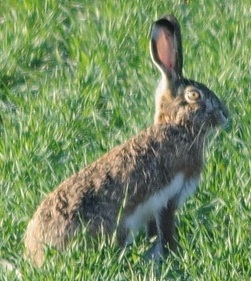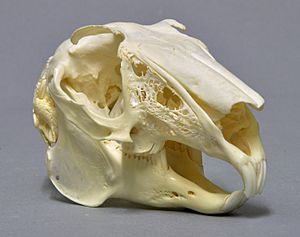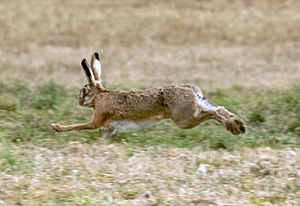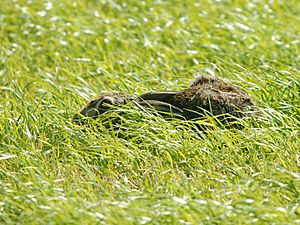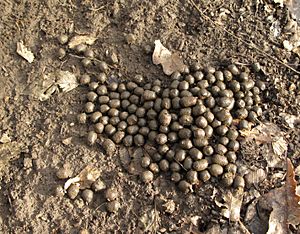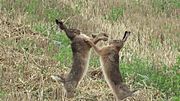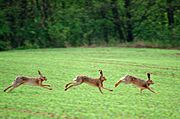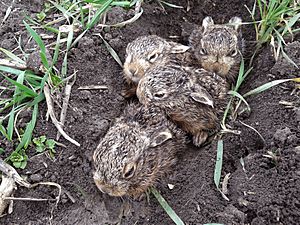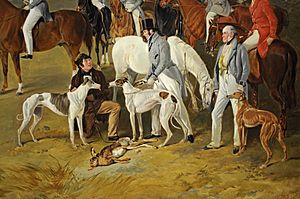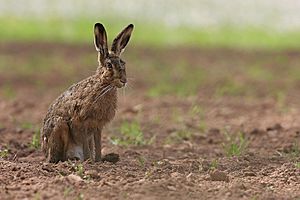European hare facts for kids
Quick facts for kids European hare |
|
|---|---|
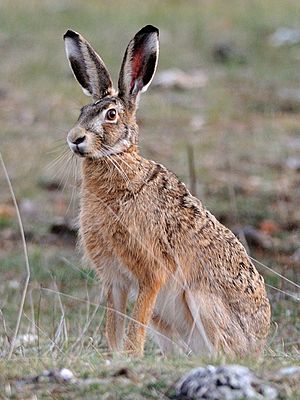 |
|
| Conservation status | |
| Scientific classification | |
| Genus: |
Lepus
|
| Species: |
europaeus
|
 |
|
| European hare range (dark red – native, red – introduced) |
|
The European hare (Lepus europaeus), also known as the brown hare, is a type of hare found in Europe and parts of Asia. It is one of the biggest hare species and lives in open, mild areas. Hares are herbivores, meaning they eat plants. They mostly munch on grasses and herbs. In winter, they also eat twigs, buds, bark, and farm crops.
Big birds of prey, dogs, and cats hunt hares. Hares escape danger by running very fast. They have long, strong legs and big nostrils that help them run for a long time.
Hares are usually active at night and are quite shy. But in spring, they act differently! You might see them chasing each other in fields during the day. Sometimes, they even hit each other with their paws, which looks like "boxing." This usually happens when a female hare hits a male. She might be showing him she's not ready to mate, or she might be testing how determined he is.
Female hares make their nests in a shallow dip on the ground, not in a burrow like rabbits. Their babies, called leverets, are born active and can move around right away. A female can have three or four babies in one litter and can have three litters a year. Hares can live for up to twelve years. They breed from January to August.
The IUCN says the European hare is of "least concern" because it lives in many places and there are still quite a few of them. However, their numbers have been going down in Europe since the 1960s. This is partly because of changes in farming. People have hunted hares in Europe for hundreds of years. More than five million are hunted each year. In Britain, hunting hares with dogs used to be common, but it is now against the law. Hares have also been a symbol of new life and growth in some cultures. Their spring behaviour led to the saying, "mad as a March hare."
Contents
What is a European Hare?
The European hare was first described in 1778 by a German scientist named Peter Simon Pallas. It belongs to the group Lepus, which is Latin for "hare." This group includes 31 other hare and jackrabbit species. Jackrabbits are just a type of hare found in North America.
Hares are different from other rabbit-like animals because they have longer legs, wider nostrils, and their young are born active. Some hares, like the Corsican hare and Granada hare, were once thought to be types of European hares. But now, scientists know they are separate species after studying their DNA and body shapes.
Scientists are still discussing if the European hare and the Cape hare are the same species. They look at different parts of their DNA to find answers. It's possible that their differences are because they live in different places, not because they are completely separate species. More research is needed to be sure.
Historically, people have described up to 30 different types of European hares, called subspecies. These types were identified by differences in their fur colour, body size, and skull shape.
Here are some of the subspecies listed by scientists:
- Lepus europaeus caspicus
- L. e. connori
- L. e. creticus
- L. e. cyprius
- L. e. cyrensis
- L. e. europaeus
- L. e. hybridus
- L. e. judeae
- L. e. karpathorum
- L. e. medius
- L. e. occidentalis
- L. e. parnassius
- L. e. ponticus
- L. e. rhodius
- L. e. syriacus
- L. e. transsylvanicus
How to Identify a European Hare
The European hare is a fast-running mammal. It has eyes high on the sides of its head, long ears, and a neck that can move easily. Its teeth keep growing all the time. The front teeth are for gnawing, and there's a space between them and the back teeth. The back teeth are good for grinding tough plants.
Hares have dark leg muscles that help them run fast for a long time in open areas. Unlike cottontail rabbits, which are built for short bursts of speed in bushy places, hares have wider nostrils and bigger hearts for endurance running.
This hare is one of the largest lagomorphs (the group that includes hares, rabbits, and pikas). Its body can be about 60 to 75 cm (24 to 30 in) long, with a tail of 7.2 to 11 cm (2.8 to 4.3 in). It usually weighs between 3 and 5 kg (6.6 and 11.0 lb). Its long ears are about 9.4 to 11.0 cm (3.7 to 4.3 in) from the bottom to the tip. Its back feet are also long, measuring 14 to 16 cm (5.5 to 6.3 in).
The fur on its back is a mix of yellow-brown. Its shoulders, legs, neck, and throat are reddish-brown. Its belly is white, and its tail and ear tips are black. The fur on its back is usually longer and more curly. Unlike some other hares, the European hare's fur does not turn completely white in winter. However, the sides of its head and the base of its ears might get some white patches, and its hips might turn a bit grey.
Where European Hares Live
European hares live naturally across much of continental Europe and parts of Asia. Their home range stretches from northern Spain to southern Scandinavia, eastern Europe, and northern parts of Western and Central Asia. They have even started moving into Siberia.
It's thought that the Romans brought hares to Britain about 2000 years ago. You won't find them in Ireland, where the mountain hare is the only native species. People have also introduced them to other places, often for hunting. These places include North America (like Ontario and New York State), parts of South America (like Brazil and Argentina), Australia, and New Zealand.
Hares mostly live in open fields with some bushes for shelter. They can adapt well and do great in mixed farmland. Studies show that hares are most common in warm, dry areas with mild winters. They need places to hide, like hedges and ditches, because these spots offer the different foods they need. They are less common in very large open fields. When farms use very intense methods, more young hares might die.
In Great Britain, you'll see hares most often on farms that grow crops, especially those with fallow land, wheat, and sugar beet. Their numbers are lower where there are many foxes or buzzards. They also seem to be fewer in areas with lots of European rabbits, even though hares and rabbits don't usually fight.
Hare Behaviour and Life Cycle
Hares are mostly active at night and spend about a third of their time looking for food. During the day, a hare hides in a shallow dip in the ground called a "form." This helps it stay partly hidden. Hares can run up to 70 km/h (43 mph). When a predator comes, they rely on their speed to outrun it in the open.
Hares are generally thought to be solitary, but you can sometimes see them in small or large groups. They don't seem to have their own territories. Instead, they share home areas of about 300 hectares (740 acres). Hares use different body signals to talk to each other. They raise their ears to show interest. Lowering their ears tells others to stay away. When challenging another hare, they thump their front feet. They use their back feet to warn others about a predator. A hare will squeal if it's hurt or scared. Female hares make "guttural" calls to attract their young. Hares can live for up to twelve years.
What Hares Eat
European hares are herbivores. They eat wild grasses and weeds. But as farming has changed, they sometimes eat crops when their favourite foods aren't available. In spring and summer, they eat soy, clover, corn poppy, and different grasses and herbs. In autumn and winter, they mostly eat winter wheat. They also like piles of sugar beet and carrots that hunters leave for them. In winter, they also eat twigs, buds, and the bark of bushes and young fruit trees.
Hares usually avoid cereal crops if there are other tastier foods around. They seem to prefer foods that give them a lot of energy. When they eat twigs, hares strip off the bark to get to the sugary parts inside. Food moves faster through a hare's body than through a rabbit's, but they digest it at a similar speed. Sometimes, hares eat their own soft, green droppings to get back proteins and vitamins they didn't digest the first time. Two or three adult hares can eat more food than one sheep!
European hares often eat in groups. Eating together is helpful because individual hares can spend more time eating. They know that other hares are watching out for danger. However, how the food is spread out affects this benefit. If food is spread widely, all hares can get to it. But if food is in clumps, only the stronger hares can reach it. In small groups, strong hares are better at protecting food. But as more hares join, they have to spend more time chasing others away. The bigger the group, the less time the strong hares have to eat. Meanwhile, the weaker hares can get food while the strong ones are busy. So, when food is in clumps, all hares do worse in groups than when food is spread out.
Hare Reproduction and Life Cycle
European hares have a long breeding season, from January to August. Female hares, called does, can be pregnant in any of these months. Male hares, called bucks, can have babies all year except in October and November. The most babies are born in March and April, when most females are pregnant with three or more babies.
The number of babies in a litter goes down as the breeding season ends. No pregnancies happen after August.
Does give birth in shallow dips in the ground. A female can have three litters in a year. Pregnancy lasts about 41 to 42 days. The young, called leverets, weigh around 130 grams (4.6 oz) when they are born. Leverets are born with fur and can move around soon after birth. This helps them because they don't have a safe burrow like rabbits do.
Leverets spread out during the day and come back together in the evening near where they were born. Their mother visits them to nurse (feed them milk) soon after sunset. The young drink milk for about five minutes. While they drink, they pee, and the mother licks up the liquid. Then, she jumps away so she doesn't leave a scent trail for predators. The leverets then spread out again. Young hares can eat solid food after two weeks and stop drinking milk when they are four weeks old. Young males often move further away from where they were born than young females. Females can have babies when they are seven or eight months old, and males can when they are six months old.
Dangers and Health of Hares
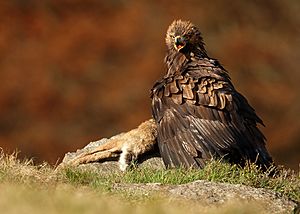
Adult European hares are big, so only large predators can hunt them. These include dogs, cats, and the biggest birds of prey. In Poland, foxes eat the most hares in spring, when there aren't many other small animals to hunt. At this time, hares can make up half of what foxes eat. About half of adult hare deaths are caused by foxes. In Scandinavia, when a disease reduced the number of red foxes, the number of European hares went up. When the foxes came back, the hare numbers went down again. The golden eagle hunts European hares in the Alps and other mountain ranges. In North America, foxes and coyotes are the most common predators. Bobcats and lynx also hunt them in wilder areas.
European hares can get both external and internal parasites. One study found that over half of hares in Slovakia had nematodes (roundworms), and over 90% had coccidia (tiny parasites). In Australia, European hares were found to have several types of worms, liver flukes, and two types of dog tapeworms. They also had rabbit fleas, other fleas, lice, and mites.
European brown hare syndrome (EBHS) is a serious disease caused by a virus. It's similar to the virus that causes rabbit haemorrhagic disease (RHD), and it can be deadly. However, the virus doesn't spread between hares and rabbits. Other diseases that can kill hares include pasteurellosis, yersiniosis, coccidiosis, and tularaemia.
In 2018, a new form of the rabbit haemorrhagic disease virus (RHDV2) was reported to have spread to hares in the UK. This virus is usually rare in hares, but it has caused many hare deaths in Spain too.
Hares and Humans
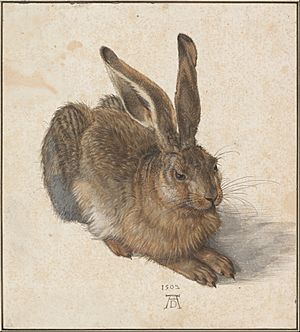
Hares in Stories and Art
In Europe, the hare has been a symbol of new life and growth since ancient times. The ancient Greeks linked it to their gods Dionysus, Aphrodite, and Artemis.
In Northern Europe, Easter pictures often show hares or rabbits. Some old customs around Easter in England involved hares. This led some people to think that the hare was a special animal in springtime celebrations long ago. People noticed how hares acted strangely during their mating season in spring. This led to the popular English saying, "mad as a March hare." This idea of a mad hare appears in Alice's Adventures in Wonderland by Lewis Carroll. In the story, Alice has a crazy tea party with the March Hare and the Mad Hatter.
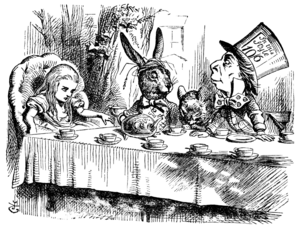
The hare is also a character in some fables, like The Tortoise and the Hare by Aesop. This story was even used by a philosopher named Zeno of Elea to explain his ideas about motion. The German Renaissance artist Albrecht Dürer painted a very realistic picture of a hare in his 1502 watercolour called Young Hare.
Hunting Hares for Food
Across Europe, over five million European hares are hunted each year. This makes them one of the most important animals hunted for sport and food on the continent. Because they are so popular, some local types of hares, like those in France and Denmark, have been threatened. This is because many hares are brought in from Eastern European countries like Hungary.
Hares have traditionally been hunted in Britain using beagles (small hunting dogs) and by hare coursing (using greyhounds to chase hares). In beagling, hunters follow the dogs on foot. In Britain, the 2004 Hunting Act made hunting hares with dogs illegal. So, the beagle packs now use fake "trails" or can legally hunt rabbits. Hare coursing with greyhounds used to be a sport for rich people. More recently, it became a less formal activity, sometimes done without the landowner's permission. This is also now illegal. In Scotland, people are worried about the increasing number of hares being hunted under special permits.
Hare meat is traditionally cooked by jugging. This means the whole hare is cut into pieces, soaked in a marinade, and cooked slowly with red wine and juniper berries in a tall pot that sits in a pan of water. It's often served with the hare's blood and port wine. Hare can also be cooked in a casserole. The meat is darker and has a stronger flavour than rabbit meat. Young hares can be roasted. Older hares' meat becomes too tough for roasting, so it's better to slow-cook it.
Hare Conservation Status
The European hare lives in many places across Europe and western Asia. It has also been brought to other countries around the world, often for hunting. Generally, there are a fair number of hares in their native areas. However, their populations have been going down in many places since the 1960s. This drop is linked to more intense farming methods.
The hare can adapt to new places, but it does best when there are many different weeds and other plants to eat along with its main diet of grasses. In some areas, the hare is seen as a pest. It is more likely to damage crops and young trees in winter when there isn't enough other food available.
The IUCN says the European hare is of "least concern" for conservation. This means it's not currently in danger of disappearing. However, when there are only a few hares in an area, they can be at risk of dying out completely. This is because there are fewer different genes in the group, which makes inbreeding more likely. This is happening in northern Spain and Greece. To help, some hares are being bred in captivity in Spain, and some are moved from one place to another to increase genetic variety. The Bern Convention lists the hare as a protected species. Several countries, like Norway, Germany, Austria, and Switzerland, have listed the hare as "near threatened" or "threatened" in their own regions.
See also
 In Spanish: Liebre común para niños
In Spanish: Liebre común para niños



